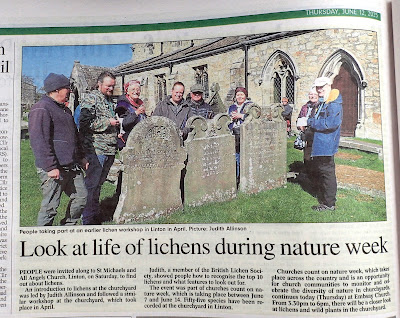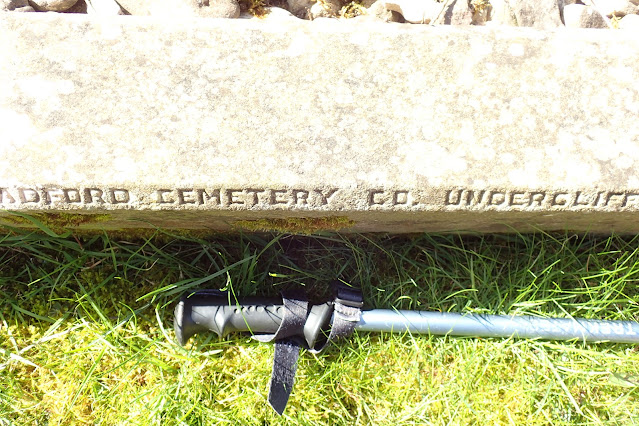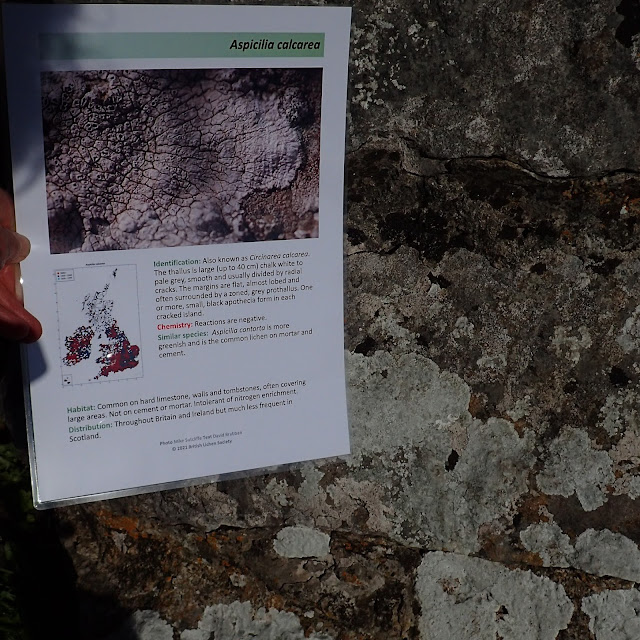As part of Churches Count on Nature Week 2025 (7-15 June) we held "An Introduction to Lichens" workshop at Linton Churchyard, near Grassington, 13.45 to 15.45 Sat 7 June. This was a follow on to the workshop held on 5 April.
 |
I wanted to see which lichens beginners would notice by themselves.
Our aim was to find
five striking lichens on siliceous rock (acid) ,
five on basic rock, and
five on trees.
five striking lichens on siliceous rock (acid) ,
five on basic rock, and
five on trees.
On the first workshop - 5 April - 8 people had attended plus three more experienced people who went on to write a species list of 56 species found. These were (we assume) still there on 7-15 June and will be sent in to the Churches Count on Nature project.
On 7 June two completely new people came (one from Grassington and one from Skipton ) plus the two second-timers from Grassington - one from the Churchyard Management Team, and one from the Upper Wharfedale Field Society.
What is a lichen?
Many people have become interested in lichens recently having heard about the mysterious symbiotic association of a fungus and an alga. (Symbiotic means the two organisms help each other). Each of te almost 2000 lichens in the UK has a different fungus, (which gives the lichen its name) - but they often use the same algae maybe a choice of 100 or so.
How do you pronounce lichen?
In universities they pronounce it "Liken" - but many other people say "Litchen" to rhyme with kitchen
It is not a moss - Mosses are actually green plants with tiny leaves.
I reminded the group that each lichen is made out of a fungus (which gives the lichen its name, and its structure) and one or more algae which can photosynthesise and thus give the lichen sugars. ("The algae" can include certain bacteria which can also photosynthesise). By helping each other the fungus and alga allow the "organism" so formed to grow in dry bare places where nothing else can grow. Each lichen is a symbiotic community of two organisms helping each other. So lichens are really tiny micro-ecosystems because they contain two or more species - the fungus and the alga,
The body of the lichen is called the thallus. The three main structural forms of lichens are:
Crustose (making a crust on the surface)
Foliose or leafy ( you can get your finger nail under the lichen)
Fruticose, or shrubby: The lichen is attached to its substratum by one point (the holdfast) and then it is branched.
I set the task of:-
"Can you find and show me
Five different species on acid gravestones and rocks (such as sandstone or slate)
Five different species on basic (alkaline) rocks such as limestone or cement or mortar
Five different species on trees?
This is what we came up with: (for most of the lichens I include a common name and a point of interest)
We stopped two graves in from the entrance gate: at the perimeter of grave next to the path and gravestones nearby;
Acid Rocks - sandstone grave edging and tombstones
- Map Lichen (Rhizocarpon geographicum) This has been sent out into outer space by the Russians on a sputnik and returned and continued growing.
Our first grave. Pointing to a tiny bright green patch of "Map Lichen"
Mid right you can also see the
big pale grey patch of our second lichen - "Cigarette Ash lichen"
Cigarette Ash Lichen - Porpidia tuberculosa: This has a big grey thallus (body) which has a half cm pale band round the edge and have navy blue dots (soralia) making the central part look dark) Cigarette ash lichen: Porpidia tuberculosa - Golden Speck Lichen Candelariella vitellina: This has lemon yellow dots and a few yellow apothecia (round jam-tartlike reproductive bodies 1.5mm across) and it does not go red with KOH - alkali. This told me it must be an acid rock.
Candelariella vitellina - Golden Speck Lichen - This is a very close-up picture - Lecanora soralifera. (No English name - possibly "Rim-lichen-with-soralia" Pastel green with (under the hand lens) some much lighter c 1mm areas. The light areas are soralia - "holes" where the contents of the crustose lichens can escape as a sort of powder and blow away and start new lichens. It grows on the top of many gritstone and sandstone walls in this area. We found it on an upright gravestone.
Looking at Map Lichen (yellow green) on an adjacent tombstone mostly covered by Lecanora soralifera 
Pointing to Map Lichen - Rhizocarpon geographicum. The writing on the tombstone is outlined with Lecanora soralifera

Lecanora soralifera - looks greener than this in real life.
This close up was not on the grave in the picture.
- Crottle or Stony Rag: Parmelia saxatilis: This grey Leafy lichen has several common names including Crottle and Stony Rag, and was used for dyeing. Under a hand lens you can see the central darker part has lots of tiny "fingers" about 0.5 to 1mm long. These can break off and spread the lichen. Parmelia saxatilis turns yellow when KOH is applied.
 |
| Parmelia saxatilis (foreground) on tomb in front of church |
 | |
|
--------------------------------
After those five ,I did get carried away showing them more lichens on acid rock. -showing them
a) Trapelia coarctata - turns red with C (bleach)
a) Trapelia coarctata - turns red with C (bleach)
b) Rhizocarpon reductum (paired with Rhizocarpon geographicum in the foldout Churchyard Lichens sheet)
d) An unknown.. Oh I wish I knew what it was)
-----------------------------------------
2. Basic rocks:
(basic means alkaline - the opposite of acid and includes rocks such as limestone, marble, cement and moratar)
Natural limestone boulder used as gravestone.
- Caloplaca flavescens Yellow pleated limestone lichen (my name)
- Verrucaria nigrescens Black Verrucaria
- Circinea calcarea (formerly Aspicilia calcarea) Limestone sunken-Rim Lichen
- Bagliettoa parmigera s. lat. (Bagliettoa baldensis, Verrucaria baldensis) - "White Verrucaria with very tiny black dots"
At this point we ran out of really obviously different lichens on this particular rock. We went to the church itself which had acid rocks held together by basic mortar - but it was difficult for novices to distinguish which substrate was which - (I realise that, because I now know many of the lichens, I can guess the substrate.)
I am thinking of adding Caloplaca citrina sens lat. - this looks like a yellow powder till you examine it closely. It turns red with KOH (Alkali)
This is an amalgamation of several different Caloplaca species: sens lat means in the wide sense.
Other candidates include Protblastenia rupestris, Lecanora albescens and Aspicilia contorta - as they are all species that con be found on cement or mortar (a habitat that can usually be found in a churchyard) - but they do not "Stand out" and are hard for beginners to notice.
The group discovered a beautiful "Blue lichen" which turned out to be streaks of stuff/mortar impregnated with copper salts just below a window with a copper grill.
3. On Trees
One young Rowan tree to the SW corner of the church
- Xanthoria parietina Common Yellow Lichen; Maritime Sunburst Lichen. (My name: yellow bird-perch lichen)
- Parmelia sulcata Hammered Shield Lichen
- Ramalina farinacea Farinose Cartilage Lichen
- Physcia tenella: Little Ciliated lichen (Cilia are hairlike/rootlike projections coming from the side of this tiny grey leafy lichen.)
- Arthonia radiata: This is crustose with tiny black radiating ink blot shaped fruiting bodies. I would call this "Ink blot" or "Star" or "Asterisk" Lichen
All these five lichens (and especially 1,4,5) are ones which will grow in air that has "reactive nitrogen compounds" - nitrogen oxides, ammonia and dust rich in fertilizer. These all act like fertilizer. - They come from slurry, from fertilizer, from traffic fumes. They are in the air most of England and southern Scotland.
 |
| Examining the Mountain Ash at Linton Churchyard |
-----------------------------------------------------------------------------------------------------------------------
This was the advert.

















No comments:
Post a Comment